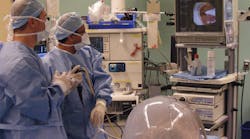An efficient way to target and repair defective genes has been discovered using human pluripotent stem cells and DNA-cutting protein from meningitis bacteria, researchers from the Morgridge Institute for Research and Northwestern University announced earlier this month.
The novel technique is much simpler than previous methods and establishes the groundwork for major advances in regenerative medicine, drug screening and biomedical research, according to the research team.
"With this system, there is the potential to repair any genetic defect, including those responsible for some forms of breast cancer, Parkinson's and other diseases," Zhonggang Hou of the Morgridge Institute's regenerative biology team said. "The fact that it can be applied to human pluripotent stem cells opens the door for meaningful therapeutic applications."
The discovery holds many practical applications according to Dr. James Thomson, director of regenerative biology at the Morgridge Institute.
"Human pluripotent stem cells can proliferate indefinitely and they give rise to virtually all human cell types, making them invaluable for regenerative medicine, drug screening and biomedical research," Thomson said. "Our collaboration with the Northwestern University team has taken us further toward realizing the full potential of these cells because we can now manipulate their genomes in a precise, efficient manner."



